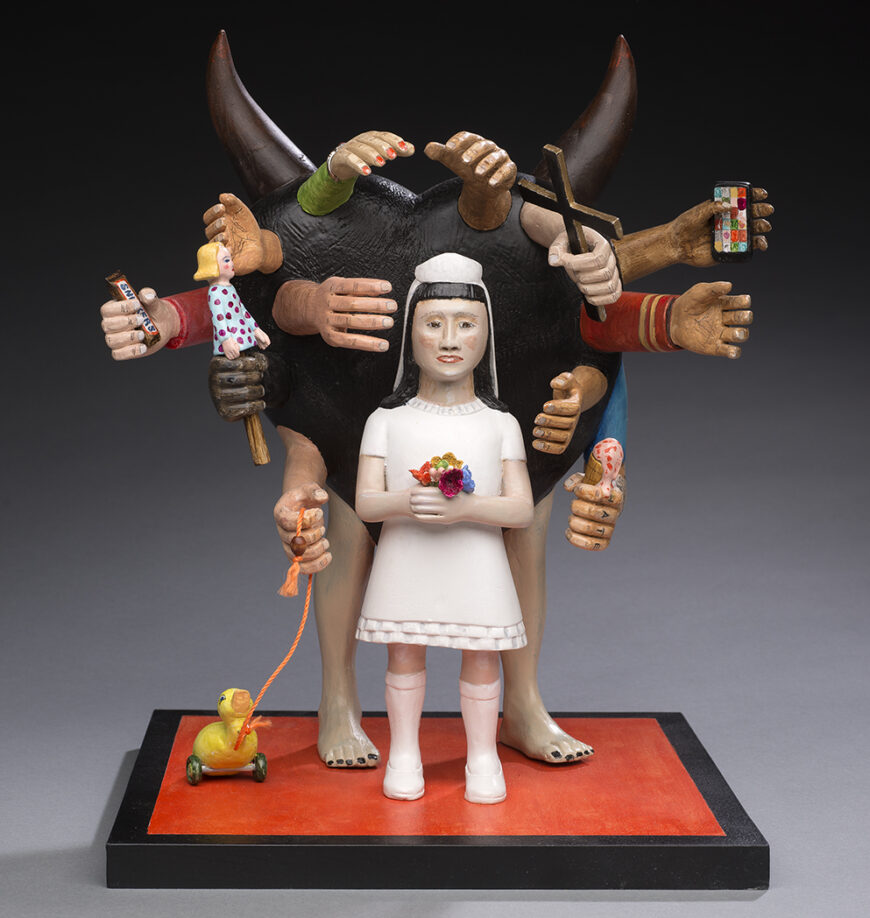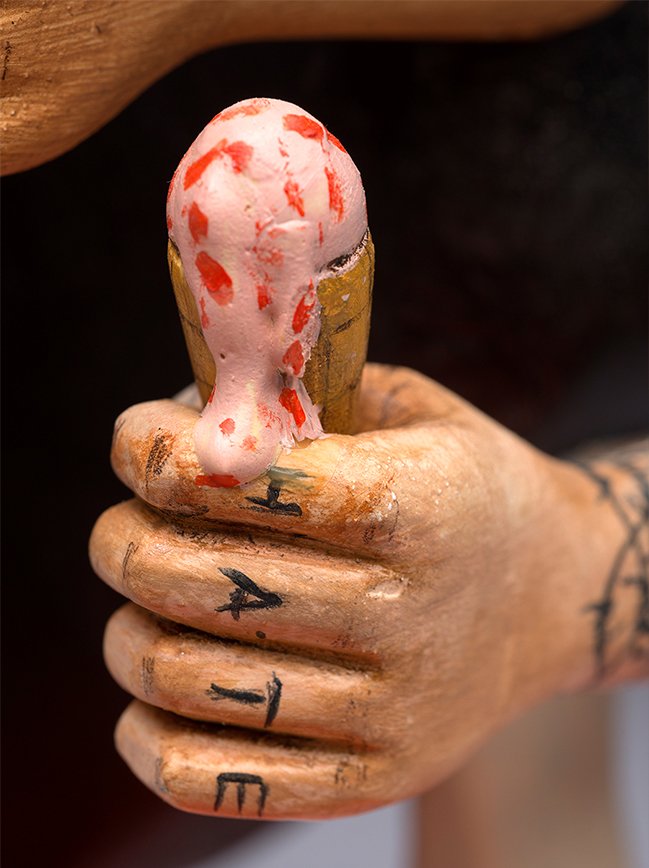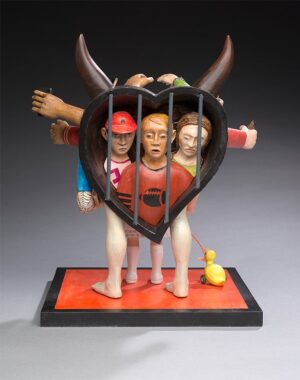
Luis Tapia, Corazón Negro, 2016, carved and painted wood, 14 1/4 x 11 5/8 x 10 1/4 inches (Collection of Maurice M. Dixon, Jr; photo: James Hart) © Luis Tapia
Corazón Negro by Chicano sculptor Luis Tapia boldly condemns the pedophilia scandals in the Catholic Church, employing a formal language that combines contemporary and colonial Mexican visual strategies. Created in 2016, the piece specifically alludes to the crimes committed against children in the 1990s in New Mexico under Archbishop Robert Sanchez in the Diocese of Santa Fe. Tapia created the work one year after the release of the 2015 movie Spotlight which shed light on the sexual abuse of minors at the hands of Catholic priests, and in the wake of numerous lawsuits and reports. The artist did not shy away from addressing such disturbing matters, and given his fluency in the visual languages of both traditional New Mexican santero art and contemporary Chicana/o art, the results are powerful.
In the context of New Mexico, santero artists (a designation that includes both painters and sculptors) dedicate their lives to representing Catholic holy figures, a tradition dating back to the 1700s, the colonial era. Called “santeros” to indicate their personal piety, these artists preserve traditional materials, techniques, iconographies, and style. Tapia’s work also operates in the context of Chicana/o art. Born into a northern New Mexican family, he became politicized during the Chicano movement of the 1960s and 1970s. Northern New Mexico was an epicenter of such activism, led by land grants crusader Reies López Tijerina, whose armed attack on the courthouse in Tierra Amarilla in 1967 brought attention to takeover of Hispanic and Mexican settlers’ land by the U.S. government in the wake of the 1848 Treaty of Guadalupe-Hidalgo. In 1986, Tapia visited Los Angeles, where he met Chicano artist Gilbert “Magu” Sánchez Luján, later spending a year working in Magu’s studio in Hollywood. They became close friends. Tapia’s sculptures reveal inspiration from Chicana/o art in their vibrant color, vernacular references, and pointed political commentaries. Corazón Negro unites these various visual strategies in a powerful 2016 condemnation of the Catholic Church.

Hate tattoo on hand (detail), Luis Tapia, Corazón Negro, 2016, carved and painted wood, 14 1/4 x 11 5/8 x 10 1/4 inches (Collection of Maurice M. Dixon, Jr; photo: James Hart) © Luis Tapia
A threatening composition
Both the title and the artist’s use of a heart as the main compositional device bring to mind the Catholic cult of the Sacred Heart of Jesus. A devotion that dates to the late 17th century, with some earlier precedents in the Middle Ages, the Sacred Heart symbolizes Christ’s boundless love for humanity. Usually represented as a flaming human heart, the devotion is very popular among Catholics of Mexican descent. Tapia uses the heart form to organize his sculpture, which stands a little over 14 inches high. Looking at the front of the piece, we see a young girl, a first communicant, dressed in white dress, veil, knee socks, and shoes, holding a small bouquet of flowers. A personified bipedal black heart, the “Corazón Negro” or “Black Heart” of the title, looms threateningly, its twelve arms and hands reaching for the child. Most of the hands are large and masculine looking, although several are more diminutive, with one displaying red fingernail polish, suggesting that women, too, were involved or complicit in child abuse. Some of the hands hold treats of the sort used to lure children. One on the left clutches a candy bar as another holds a doll figure with blond hair, a stick puppet. Below, another grasps a duck pull toy, a kind of plaything enjoyed by toddlers or very young children. A hand on the right clenches an ice cream cone, which melts onto tattooed knuckles, where the word “HATE” is spelled out. On the top right another hand is seen clutching a cell phone. Above it a large, light-colored hand presents a large wooden cross, its form held out ominously over the victim’s head. Other hands reach for the potential victim. Eerily, none of the arms or hands match up or can be paired up. They belong to women and men and represent a range of skin tones, giving visual form to the number of people involved in the scandal and cover-up. At the very top of the piece, two prominent horns rise up, a clear reference to colonial representations of Satan or the devil. Tapia’s threatening composition visualizes the extent of the abuse, its power dynamics, and the powerlessness of its victims.

Luis Tapia, Corazón Negro, 2016, carved and painted wood, 14 1/4 x 11 5/8 x 10 1/4 inches (Collection of Maurice M. Dixon, Jr; photo: James Hart) © Luis Tapia
The sculpture’s reverse side is equally compelling, where the black heart takes the form of a prison. Three sorrowful, tearful figures, two boys and a woman, are imprisoned within the heart’s bars. They are trapped, like souls in purgatory, in a composition that references colonial painting. The boys represent young male victims. One wears a baseball cap, tears running down his cheeks; the other, clad in a football jersey, opens his mouth in an expression of shock and grief. The third female figure on the right suggests the anguish of the victims’ parents. She casts down her tearful eyes, a modern-day rendition of the suffering Virgin Mary. Portions of the sculpture’s front side are visible from the back, providing further commentary. We notice, for example, the backs of six of the grasping arms and hands. An additional tattoo on the arm of the figure holding out the ice cream cone is revealed below a blue sleeve, a spider’s web, a reference to victims caught in the web of abuse. Most disturbingly, we are granted a view of four legs, two adult male legs (attached to the black heart), and between them the small calves and feet of the little girl. One notices the positioning of the legs, their size imbalance, and the duck pull toy. Here Tapia chillingly encapsulates the physical acts of pedophilia, the shocking reality of this abuse of power, and the devastating effects on innocent children. The distressing juxtaposition of these legs is brought to the viewer’s attention through the artist’s assured representational strategies—the work’s three-dimensionality, its focused composition, bold use of color, and convincing reality effects.
Colonial references and Chicana/o visual expression
In Corazón Negro Tapia powerfully combines references to colonial New Mexican santero art, identified by some as the oldest Latinx art tradition in the U.S., and to contemporary Chicana/o visual expression. As an award-winning santero, his knowledge of santero art is absolute. This knowledge comes through in his wood carving technique, his use of color, and his knowledge of Catholic religious imagery and its iconography. At the same time, though, pieces such as Corazón Negro are clearly contemporary works of Chicana/o art. Although unique in its conception and realization, it does share certain traits in common with other important Chicano sculptors, including Magu, David Ávalos, and Luis Jiménez. Like them, Tapia has a penchant for political commentary, an appreciation of vibrant color, and an investment in vernacular and historical references.
Corazón Negro reveals Luis Tapia to be both New Mexican santero and contemporary Chicano artist. His references to the past, as seen in his handling of traditional Catholic iconography such as the Sacred Heart, the suffering Madonna, the devil, and the souls in purgatory, make Latinx culture, history, and people visible as they suggest the ways that the past and present intertwine. Because his artworks engage with the colonial past as they comment on the current moment, they function as a kind of fulcrum between past and present, with the potential to question and transform histories. Such artworks vividly express, make visible, and question historical legacies. One of those legacies, addressed boldly in this work, is the harm perpetrated by the Catholic Church on the Mexican-American population.
Additional resources
View more of Luis Tapia’s work on his website
John Beardsley and Jane Livingston, Hispanic Art in the United States: Thirty Contemporary Painters and Sculptors (Houston: Museum of Fine Arts; New York: Abbeville, 1987).
Charlene Villaseñor Black, “Past, Present, and Future in the Work of Luis Tapia,” Aztlán: A Journal of Chicano Studies, volume 42, number 2 (Fall 2017), pp. 1–14.
Charlene Villaseñor Black, “Artist in Between,” Borderless: The Art of Luis Tapia, edited by Carmella Padilla, exhibition catalogue (Norman: University of Oklahoma Press, 2017), pp. 15–16.
Edward Hayes, “Cada mente es un mundo: A Day in the World of Luis Tapia,” Borderless: The Art of Luis Tapia, edited by Carmen Padilla (Norman: University of Oklahoma Press, 2017).
Laurie Beth Kalb, Crafting Devotions: Tradition in Contemporary New Mexican Santos (Albuquerque and Los Angeles: University of New Mexico Press in association with the Gene Autry Western Heritage Museum, 1994), especially chapter 1, “Chicano Art and Santos by Luis Tapia,” pp. 45–87.
Stephanie Lewthwaite, A Contested Art: Modernism and Mestizaje in New Mexico (Norman: University of Oklahoma Press, 2015).
Carmella Padilla, editor, Borderless: The Art of Luis Tapia (Norman: University of Oklahoma Press, 2017).
Jacinto Quirarte and Andrew L. Connor, Luis Tapia: ¡Ay, Que Vida! (Albuquerque: Museum of New Mexico Press; Santa Fe: Owings-Dewey Fine Art, 2002).
Luis Tapia and James Hart, Luis Tapia: Recent Works, 2017–2022 (Santa Fe: Luis Tapia, 2023).
This essay is part of Smarthistory’s Latinx Futures project and was made possible thanks to support from the Terra Foundation for American Art.


